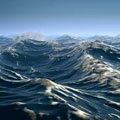Each year, about a quarter of the carbon dioxide we release into the atmosphere ends up in the ocean, but how it happens is still not fully understood. The Sentinel-3A satellite is poised to play an important role in shedding new light on this exchange.
Each year, about a quarter of the carbon dioxide we release into the atmosphere ends up in the ocean, but how it happens is still not fully understood. The Sentinel-3A satellite is poised to play an important role in shedding new light on this exchange.
Initially, the fact that the oceans are absorbing a significant amount of the carbon dioxide we pump into the atmosphere by burning biomass and fossil fuels would appear to be a good thing. However, as more carbon dioxide dissolves into the oceans, it leads to ocean acidification, making it difficult for some marine life to survive.
Monitoring and understanding the carbon cycle is important because carbon is the fundamental building block of all living organisms. Also, the process of carbon moving between the oceans, atmosphere, land and ecosystems helps to control our climate.
Over the last four years an international team of scientists and engineers have been using satellites along with measurements from ships and pioneering cloud computing techniques to study how carbon dioxide is transferred from the atmosphere into the oceans.
